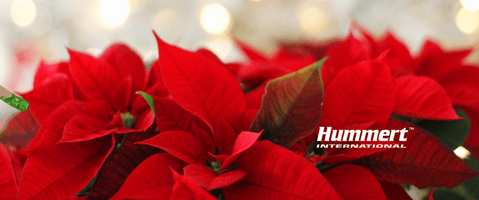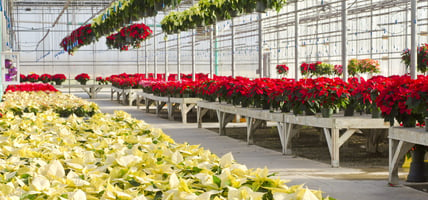Pre-finished plants are the answer to minimizing crop loss and maximizing your organization or...
Poinsettia Biological Insect Control
Poinsettias are like most greenhouse crops when it comes to pest issues…
…insects can be a pest. The most common poinsettia insect pests are some of the most common greenhouse pests- whitefly & thrips and shorefly & fungus gnats. The basic tenants of IPM (Integrated Pest Management) are the backbone to build a sound biological pest control program.
Start at box opening, check for insect pests, quarantine infected material, and identify the insect pests. Make sure that your facility is clean with limited places for insects to hide and reproduce. Standard application protocol calendars used in traditional chemical pest control don’t translate to biologicals as easily. Scouting remains a vital tool as each crop of poinsettias is different from season to season.

 As the crop grows the density of leaves makes it more difficult for insecticide sprays to reach inside the canopy where many insect pests live. This too means scouting with yellow sticky cards and regular population counts is important for success. Biological best control and pesticides can co-exist in the same pest control program but need to be researched for compatibility. Each grower will need to make decisions for their crop in an ongoing format. A combination of scouting, previous experience, current information, and a little grower anticipation will allow the grower to stay ahead of poinsettia pests.
As the crop grows the density of leaves makes it more difficult for insecticide sprays to reach inside the canopy where many insect pests live. This too means scouting with yellow sticky cards and regular population counts is important for success. Biological best control and pesticides can co-exist in the same pest control program but need to be researched for compatibility. Each grower will need to make decisions for their crop in an ongoing format. A combination of scouting, previous experience, current information, and a little grower anticipation will allow the grower to stay ahead of poinsettia pests.
Beneficial Insects for Whiteflies & Thrips

Whitefly & Thrips: Typically applied from cardboard tubes that can be shaken over the crop. Target above-ground parts of poinsettias.
Click on the beneficial insects to learn how to order
- Amblyseius swirskii – predatory mite; feeds on whitefly eggs and whitefly and thrips larvae. Also, will feed on spider and other mites. Works in warmer greenhouse temperatures.
- Eretmocerus eremicus – parasitic wasps; parasitizes larval stages of whitefly, works in high temperatures, can coordinate with pesticides easier than other biological insects.
- Encarsia formosa – parasitic wasp; one of the most common biological insect control agents for poinsettias. Population increases fast, works on larval whiteflies, works at lower temperatures
Beneficial Insects for Shoreflies & Fungus Gnats
Shorefly and Fungus Gnats – Soil Dwelling
Click on the beneficial insects to learn how to order
- Nematodes – microscopic, small worms that can be applied via a greenhouses dosing system mixed with water.

- Steinernema – nematode; works at low to high temperatures, works best on soil-dwelling larvae such as fungus gnats, leaf miner, shore & crane flies. Population will reproduce in soil building additional nematodes.
- Stratiolaelaps scimitus – soil-dwelling mite; feeds on larvae ranging from fungus gnats to thrips. Can survive on organic matter for short periods. Easily spread from the container.
- Dalotia (Atheta) coriaria – beetle; larvae are preferred food source but will feed on some adult stages and eggs, survive in diverse growing media, can fly, may hang around greenhouse after crop is sold.




